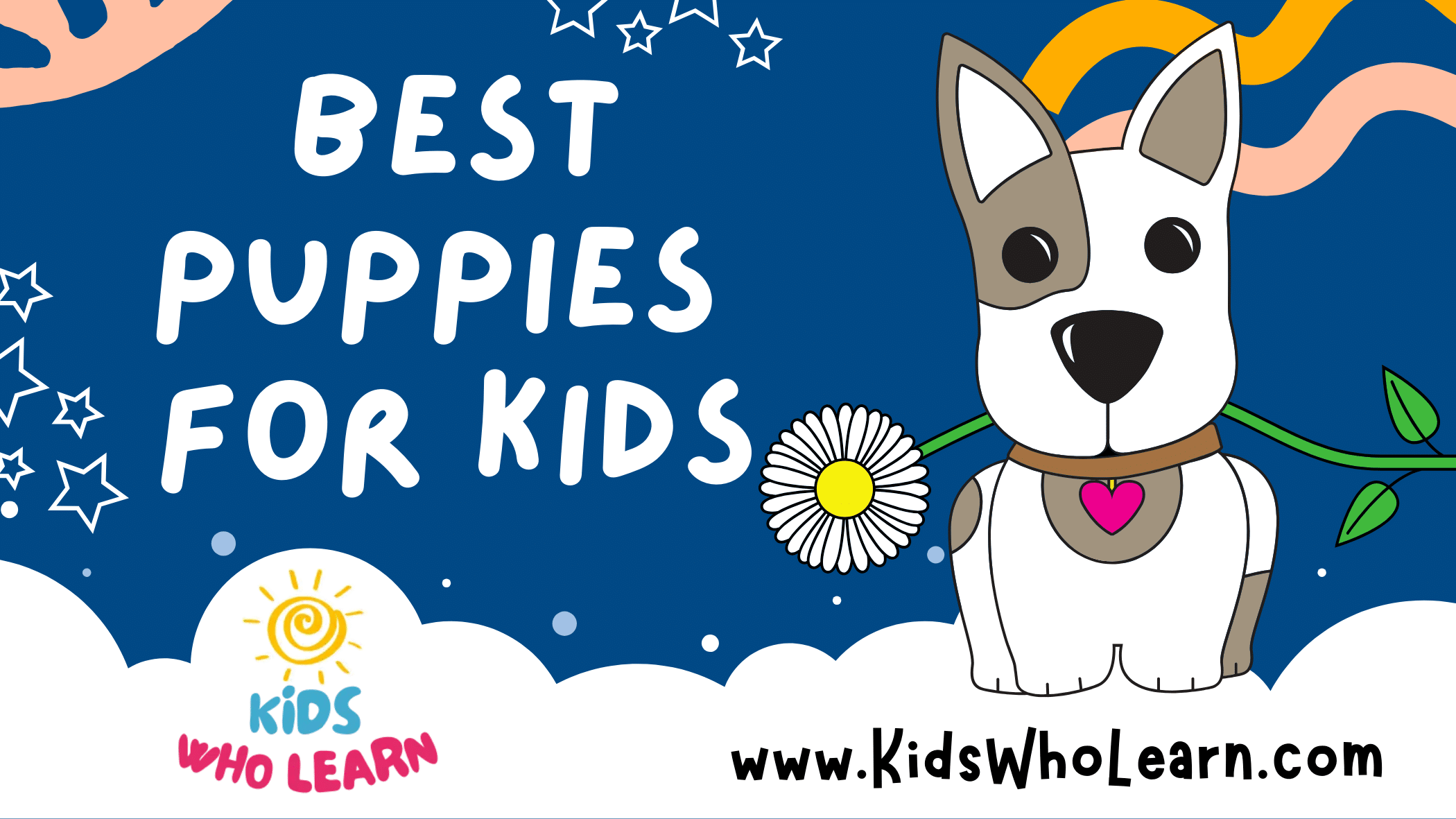Selecting the best puppy for a family with children involves more than just choosing a cute companion; it’s about finding the right temperament, size, breed, and energy level to match your family’s lifestyle. A dog that is good with kids is typically patient, gentle, and tolerant, and certain breeds are known for these traits more than others. The process involves understanding the unique characteristics of each breed, as well as considering the individual personality of each puppy.
Beyond breed characteristics, it’s also crucial to factor in the overall health and wellness of the puppy. A healthy dog not only ensures a longer and happier life together but also means fewer visits to the vet. Additionally, early training and socialization play a significant role in how well a dog integrates into a family, interacts with children, and adapts to various situations. Committing to these aspects can greatly influence the positive experiences you and your children will have with your new furry family member.
Key Takeaways
- Selecting a puppy for children requires considering temperament, breed, and energy compatibility with your family.
- A puppy’s health and wellness are crucial for their integration into a family and for long-term care.
- Early training and socialization are key to ensuring a good relationship between the dog and your children.
Understanding Puppy Temperaments
When selecting a puppy for your family, it’s crucial to understand that a puppy’s temperament can dictate how well it will integrate into your home and life with young children.
Assessing Temperament in Breeds
Different breeds exhibit varying temperaments, which can influence their suitability for families with children. For instance, Labrador Retrievers are known for being friendly and good-natured, making them ideal family dogs. On the other hand, some breeds may require an owner with more experience in dog handling or training. To help gauge a breed’s general disposition, use the following checklist:
- Affectionate: Will the breed likely enjoy cuddles and gentle play with kids?
- Energy Levels: Does the breed have a high or low energy level, and can you meet its exercise needs?
- Friendliness: Is the breed typically sociable with new people and other pets?
- Even-Tempered: How does the breed handle stress or unexpected situations?
The Impact of a Puppy’s Age on Behavior
The age of a puppy often affects its behavior significantly. Young puppies are more malleable and may adapt more easily to a family environment, but they also require more training and socialization. An adult dog may have a more established personality, which can help you understand if they’re a good fit for your family’s routine and lifestyle. Keep in mind that:
- Puppies aged 8-12 weeks are ideal for training.
- Older puppies may have more predictable behavior.
The Role of Exercise in Puppy Behavior
Exercise is a vital factor in a puppy’s development and behavior. Adequate play and physical activity can help manage a puppy’s energy levels, which in turn can influence how they interact with kids and adults alike. Consider the following to maintain a well-behaved puppy:
- Daily walks, runs, or playtime to manage energy.
- Consistent exercise routines to prevent boredom and destructive behaviors.
Incorporating these aspects into your decision-making process will lead to a more harmonious match between a puppy’s temperament and your family’s needs.
Choosing the Right Size and Breed
When selecting a puppy for children, it’s essential to consider size and breed characteristics. Each size category offers breeds that are well-suited to living with children, and certain breeds may be more compatible for those with allergies.
Small Dogs Suitable for Kids
Small dogs are often ideal for young children due to their manageable size and typically affectionate nature. However, small size does not always equate to energy level or temperament.
- Beagle: With a height of about 13-15 inches and weight around 20-30 pounds, Beagles are friendly and curious.
- Pug: Pugs stand at around 10-13 inches tall, weigh 14-18 pounds, and are known for their sociable and gentle behavior.
- Cavalier King Charles Spaniel: At 12-13 inches in height and 13-18 pounds in weight, these dogs are affectionate and good with kids.
Medium-Sized Dogs for Active Children
Medium-sized breeds can keep up with energetic kids and generally require more exercise, which encourages physical activity for the whole family.
- French Bulldog: Typically under 28 pounds with a height of 11-13 inches, French Bulldogs are adaptable and enjoy playtime.
- Boston Terrier: A height of 15-17 inches and weight up to 25 pounds make them sturdy companions for children.
- Bulldog: They’re calm, courageous, and weigh 40-50 pounds. Bulldog’s height ranges between 14-15 inches.
Large Kid-Friendly Dog Breeds
Large dog breeds can be gentle giants and often provide protective companionship for children. Supervision with smaller kids is imperative due to size.
- Golden Retriever: Known for their friendly demeanor, typically 55-75 pounds and 20-24 inches tall.
- Labrador Retriever: Similar in size to the Golden, Labradors are also known for their loving nature and trainability.
- Boxer: Boxers are playful and protective, standing at about 21-25 inches tall and weighing 65-80 pounds.
Hypoallergenic Breeds for Allergy Sensitivities
For households concerned with allergies, certain breeds with non-shedding coats are preferable.
- Poodle: Available in three sizes (standard, miniature, and toy), Poodles are intelligent and have a hypoallergenic coat.
- Bichon Frise: Small, standing around 9-12 inches and weighing 12-18 pounds with a fluffy white coat that is less likely to cause allergies.
Health and Wellness Considerations
When selecting the best puppies for children, it’s important to consider their health and wellness to ensure they fit into your family lifestyle and fulfill the responsibility of being a family dog.
Addressing Common Health Issues
Selecting a healthy puppy starts with a reputable breeder or rescue organization. These puppies should be screened for hereditary conditions. You should be aware that mixed breeds, or mutts, often have fewer health problems due to their genetic diversity. Keep an eye on signs of anxiety or distress, as mental health is crucial for a family dog. Life expectancies vary, so understand the commitment you are making; for example, smaller breeds tend to live longer than larger ones.
Grooming Needs and Maintenance
Understand the grooming needs of your puppy. A dog’s coat can range from short and smooth to long and wiry, impacting the time you’ll spend brushing and grooming. For example:
- Short-coated dogs: Require less frequent brushing but more regular baths.
- Long-coated or wiry dogs: May need professional grooming to manage their coat.
Regular grooming prevents tangles and matting and can help reduce the chance of skin issues. Remember, dogs of various colors and coat types may require different grooming products and schedules.
The Importance of a Proper Diet and Nutrition
Your puppy’s diet influences their energy levels and overall health. Ensure you’re providing:
- High-quality puppy food suitable for their age, size, and energy needs.
- Consistent feeding times to establish a routine.
- The right balance of nutrients to support growth and exercise requirements.
A proper diet and nutrition are pivotal in preventing obesity and related health complications, contributing to a longer and healthier life.
Training and Socialization
Training your puppy effectively and early on is crucial to its development, as is proper socialization, especially if the puppy will be around young children and other pets. Establishing these routines sets the foundation for a well-mannered adult dog and ensures a safer, more harmonious environment for everyone in the family.
Establishing Basic Training Routines
When starting your puppy’s training, focus on basic commands such as sit, stay, and come. Use positive reinforcement techniques like treats and praise to encourage good behavior. Here’s a simple structure to get you started:
- Consistency is Key: Always use the same commands to avoid confusion.
- Short Sessions: Keep training sessions short, 5-10 minutes, to maintain your puppy’s attention.
- Incremental Difficulty: Gradually increase difficulty and distractions as your puppy masters commands.
Training imparts important lessons on responsibility and can prevent scenarios where a puppy might escape or act unpredictably. Always supervise interactions with young children to prevent roughhousing and ensure both the pet and the child understand the limits.
Socialization with Kids and Other Pets
Socializing your puppy is essential for developing a friendly and confident dog that interacts well with kids and integrates into packs or groups of other dogs. Keep these pointers in mind:
- Introduce your puppy to a variety of people, especially kids, to develop familiarity.
- Supervise playtime to make sure interactions with children and pets aren’t too rough.
- On a leash, let your puppy meet other well-behaved and trained dogs.
This early socialization helps your dog learn proper behavior and energy levels acceptable around families and other animals. Your vigilance now will lead to easier and safer interactions for your puppy as it grows into an adult dog.
Dog Breeds and Lifestyle Compatibility
Choosing the right dog breed for your family depends heavily on your lifestyle. Whether you live in an apartment, have an active household, or have children that enjoy rough play, there’s a breed that fits your life.
Best Breeds for Active Families
For families that are always on the move and enjoy outdoor activities, selecting an energetic and athletic breed is crucial. Labrador Retrievers and Golden Retrievers are known for their friendly nature and stamina, making them great companions on hikes or runs. Alternatively, the German Shepherd is a versatile breed that thrives on mental and physical challenges, ideal for active households.
Breeds Suited for Apartment Living
Living in an apartment doesn’t mean you have to forgo the joy of having a dog. Breeds like the French Bulldog and Pug are great choices due to their smaller size and moderate energy levels. They fit well into compact spaces and still provide plenty of affection.
- Havanese: small yet sturdy, ideal for apartment dwellers.
- Bulldog: calm demeanor, requires minimal exercise.
Family Dogs that can Handle Rough Play
Kids often play rough without understanding their own strength, so it’s essential to find a dog that is both sturdy and even-tempered. Breeds like the Boxer, Bull Terrier, and English Bulldog are known for their robust build and patience with children. They are capable of withstanding a bit of roughhousing while remaining gentle.
Friendly Breeds that are Eager to Please
A dog that is eager to please and easy to train makes for a joyful addition to any family. Breeds such as the Collie and Irish Setter are known for their friendly demeanor and willingness to listen to their owners. The Bernese Mountain Dog (Bernese) is also renowned for its friendly attitude and desire to be an integral part of family activities.
Frequently Asked Questions
When selecting the perfect puppy for your family, prioritize breeds known for their gentle demeanor with children, ease of training, and specific grooming needs that match your lifestyle.
What factors should be considered when selecting a family-friendly dog breed?
Consider the breed’s temperament, energy level, size, and grooming requirements when choosing a dog for your family. You want a breed that is patient, has an agreeable nature with kids, and aligns with your family’s daily routine and living space.
Which dog breeds are known for being gentle with children?
Golden Retrievers, Labradors, and Beagles are known for their gentle and patient temperament with children. They are affectionate, playful, and thrive in family environments, making them excellent choices for households with kids.
How can I identify a suitable dog breed for homes with kids?
Look for breeds with a history of being good family dogs. Research parental and breed-specific traits, and observe interactions between the dog and your children. Also, consider adopting from shelters where you can find mixed breeds that might exhibit child-friendly characteristics.
What low-shedding dog breeds are ideal for families with children?
Breeds like Poodles, Bichon Frises, and Shih Tzus are known for their low-shedding coats, which can be better for families with allergies. Regular grooming is still necessary to maintain their coat and prevent matting.
Which dog breeds are easiest to train and good with kids?
Breeds such as Border Collies, Poodles, and Vizslas are amongst the easiest to train due to their intelligence and eagerness to please. They can be great with kids, fostering a learning environment for both the dog and the children.
What are the characteristics of a good first dog for a child?
A good first dog is typically one with a stable temperament, is forgiving of a child’s mistakes, and is neither too large nor too small. An ideal first dog is also low-maintenance, requiring minimal grooming and exercise needs, adapting well to family life.









